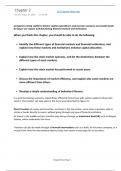Chapter 2 Ch2 Teacher Notes.doc
Sunday, August 25, 2024 11:10 AM
Companies raising capital to finance capital expenditures and investors saving to accumulate funds
for future use require well-functioning financial markets and institutions.
When you finish this chapter, you should be able to do the following:
• Identify the different types of financial markets and financial institutions, and
explain how these markets and institutions enhance capital allocation.
• Explain how the stock market operates, and list the distinctions between the
different types of stock markets.
• Explain how the stock market has performed in recent years.
• Discuss the importance of market efficiency, and explain why some markets are
more efficient than others.
• Develop a simple understanding of behavioral finance.
In a well-functioning economy, capital flows efficiently from those with surplus capital to those who
need it. This transfer can take place in the three ways described in Figure 2.1.
Direct transfers of money and securities, as shown in the top section, occur when a business sells its
stocks or bonds directly to savers, without going through any type of financial institution.
As shown in the middle section, transfers may also go through an investment bank (IB) such as Morgan
Stanley, which underwrites the issue.
Transfers can also be made through a financial intermediary such as a bank, an insurance company, or a
mutual fund. Here the intermediary obtains funds from savers in exchange for its securities.
Chapter Notes Page 1
, markets is plural; there are many different financial markets in a developed economy such as that
of the United States.
1. Physical asset markets versus financial asset markets. Physical asset markets (also called
“tangible” or “real” asset markets) are for products such as wheat, autos, real estate, computers,
and machinery. Financial asset markets, on the other hand, deal with stocks, bonds, notes, and
mortgages. Financial markets also deal with derivative securities whose values are derived from
changes in the prices of other assets. A share of Ford stock is a “pure financial asset,” while an
option to buy Ford shares is a derivative security whose value depends on the price of Ford stock.
2. Spot markets versus futures markets. Spot markets are markets in which assets are bought or sold
for “on-the-spot” delivery (literally, within a few days). Futures markets are markets in which
participants agree today to buy or sell an asset at some future date. For example, a farmer may
enter into a futures contract in which he agrees today to sell 5,000 bushels of soybeans 6 months
from now at a price of $10.275 a bushel. To continue that example, a food processor that needs
soybeans in the future may enter into a futures contract in which it agrees to buy soybeans 6
months from now. Such a transaction can reduce, or hedge, the risks faced by both the farmer and
the food processor.
3. Money markets versus capital markets. Money markets are the markets for short-term, highly
liquid debt securities. The New York, London, and Tokyo money markets are among the world’s
largest. Capital markets are the markets for intermediate- or long-term debt and corporate stocks.
The New York Stock Exchange, where the stocks of the largest U.S. corporations are traded, is a
prime example of a capital market. There is no hard-and-fast rule, but in a description of debt
markets, short-term generally means less than 1 year, intermediate-term means 1 to 10 years, and
long-term means more than 10 years.
4. Primary markets versus secondary markets. Primary markets are the markets in which
corporations raise new capital. If GE were to sell a new issue of common stock to raise capital, a
primary market transaction would take place. The corporation selling the newly created stock, GE,
receives the proceeds from the sale in a primary market transaction. Secondary markets are
Chapter Notes Page 2





